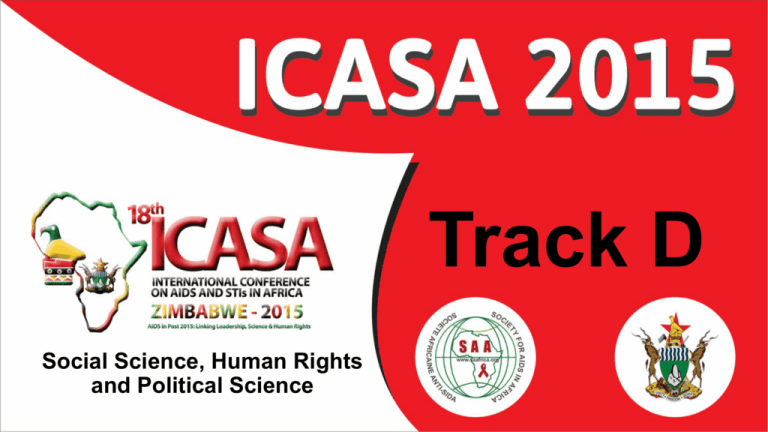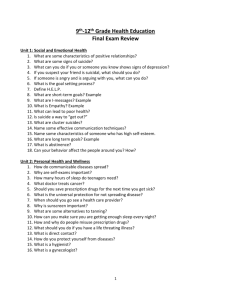
Track D
Social Science, Human Rights
and Political Science
Introduction
• 13 sessions
• 56 presentations of the scheduled 79
2
Track D Members
Member
Country of origin
1. Isabelle Bodea
Benin
2. Alain Azondekon
Benin
3. Olympia Laswai
Tanzania
4. Notion Gombe
Zimbabwe (Lead rapporteur)
5. Howard Nyika
Zimbabwe
6. Tsitsi Juru
Zimbabwe
7. Donewell Bangure
Zimbabwe
8. Ester Muchenje
Zimbabwe
9. Faith Mutsigiri
Zimbabwe
3
Track D Members
Member
Country of origin
10. Obert Manyeza
Zimbabwe
11. More Mungati
Zimbabwe
12. Tabeth Mhonde
Zimbabwe
13. Roy Chiruvu
Zimbabwe
14. Takura Matare
Zimbabwe
15. Munyaradzi Dobbie
Zimbabwe
16. Zorodzai Jakopo
Zimbabwe
17. Emelia Chikoko
Zimbabwe
4
5
Session highlights
6
D1: Increasing access to treatment and
adherence
• Follow up of patients crucial in improving adherence
• Addressing stigma, confidentiality and food access are
crucial for adherence
• Women with a history of miscarriage and stillbirth were more
likely to be HIV positive
• National Health Insurance Scheme (2005) in Ghana resulted
in improved access to treatment of PLHIV
• Retention in care improved and out of pocket expenditure for
individuals declined
7
D2: Increasing access to integrated SRHR & HIV
• Concern raised about high proportion of women not using
contraceptive
• SRH counseling did not have an effect on having unintended
pregnancies or contracting STIs
• Men accepted the PMTCT program and perceived their
participation as important for the success of the program
• Men in general fear being tested
8
D3: Programming for access to justice and care
• Highlighted human rights abuse against sex workers in
Zimbabwe as well as unreported cases of abuse
• Rapid response in providing legal services to sex workers
needed
• There is unjustified incarceration of SW
• Criminalization of sex work contributing to violation of human
rights
9
D4: Stigma, discrimination and disclosure
• Culturally sensitive interventions that help increase parental HIV
disclosure are needed.
• The project result show significant improvement among
participants in a number of areas including self-stigma,
depression and fears around disclosure.
10
D5: Sex workers access to services and human
rights
• Highlighted hepatitis B infection is an indication of unprotected
sex which also means a risk for HIV and other STIs among
these MSWs.
• Despite sensitization human rights violations are still
happening with sex workers being denied access to health
care.
• Health workers need to uphold the Hippocratic Oath in their
conduct and avoid disclosure without the consent of those
concerned.
11
D6: Community engagement
• Little attention has been accorded for socio-cultural and
governance dimensions against effects of HIV/AIDS.
• Psycho-social support, culture and local governance are
emerging determinants of HIV/AIDS reduction.
• Social capital is key for human behavior change but can be
limited by poor governance.
• HIV is not a barrier to economic empowerment to women.
• Holistic approach to empowerment is key to addressing
HIV/AIDS in communities.
12
D7: Reaching adolescents/young people with
HIV messages
• People prefer stand-alone HIV testing to health facility. (poor
confidentiality)
• Early exposure to sexual violence was associated with
sexual risk-taking behavior in adulthood among both males
and females.
• Sixty percent of unmarried women used condoms
13
D8: HIV and disability
• Strong social exclusion of deaf people was evident yet they are highly
affected with HIV/AIDS.
• HTC uptake among PWDs was 10% and 85% did not collect their
results.
• Access to health services remains a challenge to PWDs
• PWDs have increased risk of contracting HIV
• Only 2% of the PWDs had been reached with peer education yet 75%
of the respondents were sexually active
• Violence against peoples living with disabilities has been shown to
increase the risk of transmission of HIV two fold.
14
D10: Adolescents living with HIV
• Lack of privacy and side effects were some of the reasons for nonadherence.
• Adolescents friendly centers help to improve treatment outcomes
and offer support to the teens.
• Stigma and discrimination is the leading barrier to accessing
treatment among young people living with HIV, followed by side
effects and lack of food.
• Community Adolescent Treatment Supporter (CATS) services
improved adherence from 44% to 71.8% in Gokwe South District,
Zimbabwe
15
D11: HIV and law
• All international conventions now at par with municipal law in Kenya.
• Discrimination on the basis of HIV status is illegal in Kenya and can be
challenged in court.
• Need to partner with relevant stakeholders in particular
parliamentarians for sustainable HIV programming.
16
D12: Sexual and Gender Based Violence
• Sexual and Gender Based violence has been reported in schools.
• Female teachers are among perpetrators of violence
• Persistent and sustained advocacy works for reducing GBV and
IPV
• Greater internal and external stigma were independent risk
factors for verbal and sexual violence
17
D13: Information technology and
communication (ICT)
• SAFAIDS piloted the use of mHealth to further improve linkages
between health facilities and communities for improved enrollment
and retention in care of HIV clients
• mHealth contribute to improved linkage to care between health
facilities and communities
• Number of clients with appointments followed up increased by
400% per month and lost to follow up defaulters decreased by
55%.
18
Thank you
19




